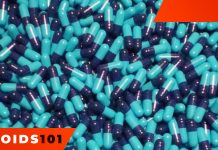The processes of fat burning and muscle growth depend on many factors, including the consumption of glycogen. But how does it affect your body? How can this substance be replenished? These are the questions that every athlete should know the answers to.
What is Glycogen?
Proteins, fats and carbohydrates – these are the three main sources of energy for the human body. It takes a certain amount of time to break down the first two macronutrients, therefore they are referred to as the «slow» form of energy, and carbohydrates that are broken down almost instantly are referred to as «fast».
The reason behind high speed of absorption of carbohydrates is that it is used in the form of glucose. It is stored in the tissues of the human body in a bound rather than pure form. This helps to avoid an overabundance that can provoke the development of diabetes. It is the main form in which glucose is stored in the body.
Where is Glycogen Accumulated?
The total amount of glycogen in the body is 200-300 grams. About 100-120 grams of the substance accumulates in the liver, the rest is stored in the muscles and makes up a maximum of 1% of their total mass.
How Much Glycogen is In the Muscles?
Glycogen accumulates in nutrient fluid surrounding the muscle – sarcoplasm. Muscle building is significantly determined by the amount of sarcoplasm. The higher this amount, the more fluid is absorbed by muscle fibers.
Heavy physical activity provokes an increase in sarcoplasm. With rising demand for glucose, which goes to muscle growth, the volume of reserve storage for glycogen also increases. Its size remains stable in the absence of any training.
Fat Burning and Glycogen
For an hour of physical aerobic and anaerobic exercise, the body requires about 100-150 grams of glycogen. When the available reserves of this substance are exhausted, the body begins to use muscle fibers and then adipose tissue as sources of energy, evidently destroying those gradually.
To get rid of excess fat, it is most effective to train after a long break since the last meal, when glycogen stores are depleted, for example, on an empty stomach in the morning. The average pace of training is ok for this purpose.
Muscle Building and Glycogen
The success of strength training for muscle growth directly depends on the availability of a sufficient amount of glycogen both for exercise and for the restoration of its reserves after it. If this condition is not met, the muscles are burned during training instead of growing.
Eating too much before the workout is also not recommended. The intervals between meals and strength training should gradually increase. It allows the body to learn how to manage available reserves more efficiently. On this principle, for example, the interval fasting is based.

General Replenishment
Transformed glucose, accumulated by the liver and muscle tissues, is formed as a result of the breakdown of complex carbohydrates. First, they break down to simple nutrients, and then into glucose that enters the bloodstream, which is converted to glycogen.
Carbohydrates with a low glycemic index give energy much slower, which leads to glycogen forming instead of fat. You should not focus only on the glycemic index, however, and mind the amount of carbs you consume.
Replenishment after Workout
The «metabolic window» that opens right after training is considered the best time to take carbs in order to replenish glycogen stores and trigger the muscle growth mechanism. In this process, carbs play a more significant part than proteins. As recent studies have shown, nutrition after training is more important than prior to it.
Conclusion
Glycogen is the main form of glucose storage, the amount of which in the body of an adult varies from 200 to 300g. Strength training, provided there’s not enough glycogen in the muscle fibers, leads to the loss of muscle mass.



